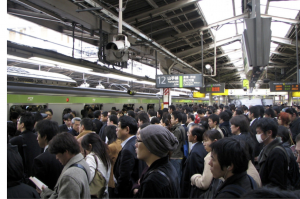Jan 08
2015
0
comments
Japanese culture explained in one photo
 People frequently ask me to explain why their Japanese colleagues and/or business partners conduct business the way they do. I explain why, give advice and yes, most people say they got it. But I often wonder whether they really “got it.” Understanding culture is difficult and usually cannot be easily explained in words.
People frequently ask me to explain why their Japanese colleagues and/or business partners conduct business the way they do. I explain why, give advice and yes, most people say they got it. But I often wonder whether they really “got it.” Understanding culture is difficult and usually cannot be easily explained in words.Last August, I gave a crash course on Japanese culture via webinar for the executives of a global entertainment company. When I showed a photo of a typical train station and described the morning rush hour commute, there was clearly an “A-ha moment” for the executives. Many interesting questions were asked (e.g. “Why is the person wearing a mask?”). The Japanese mindset of conformity and consistency was captured in this one simple photo.
 More than 35 million people live in metropolitan Tokyo, the largest metropolitan area in the world. Most people use public transportation, and you’d be amazed at what goes on at the hub stations. Hundreds of trains are coming and going, people are pouring into and out of the station, there is not an inch to spare and not a second to waste. At Shinjuku Station, one of the busiest station on the planet, when each train stops, about 4000 people have to get off and another 4,000 people have to get on within 30 seconds*.
More than 35 million people live in metropolitan Tokyo, the largest metropolitan area in the world. Most people use public transportation, and you’d be amazed at what goes on at the hub stations. Hundreds of trains are coming and going, people are pouring into and out of the station, there is not an inch to spare and not a second to waste. At Shinjuku Station, one of the busiest station on the planet, when each train stops, about 4000 people have to get off and another 4,000 people have to get on within 30 seconds*.If anything goes wrong and the system malfunctions, chaos threatens and nobody will make it to their destination on time. The system has to be super efficient, every move has to be coordinated, everything has to work on schedule, and every second counts. To make this work the commuters play a starring role in what I call the “morning dance.” Here are the unspoken rules:
- When the train arrives, people who want to board automatically line up on both sides of the door in 4 rows.
- If you’re inside the train and near the door, when the train arrives at the station, you have to quickly get out even if it’s not your stop to let others quickly get out.
- When you board the train, get in deeply to make as much room as possible for other passengers, even if you are all packed together like sardines. If you have a bag, make sure you hold it in front of you to show that you’re making the most space possible for others.
- Yes, you will be squashed inside the train and the railway employee may have to push you in even farther so that the doors will close. Everyone has to get in. Never complain. This is part of the dance.
- Don’t try to stick with you’re friend/colleague in the train. This will disturb the flow. Most likely, he/she is washed away in the sea anyway so don’t fight it.
- If you have the flu or a cold, wear a mask. Even the slightest act of spreading the flu is considered very rude. You’re too close!
- Never stop and look for directions at the platform. You should be fully aware of which exit you’re heading towards. Do you homework.
- Keep the right side of the escalator open for people who are rushing. If you don’t, you’ll stop the flow causing massive congestion.
Remember, this is a dance on a very crowded dance floor. One bad move and you’ll turn the world into complete chaos. If you could have a bird’s eye view of Shinjyuku Station during rush hour, you could really see the Japanese mindset of conformity and consistency in action.
* http://www.channel5.com/shows/worlds-busiest/episodes/train-station

